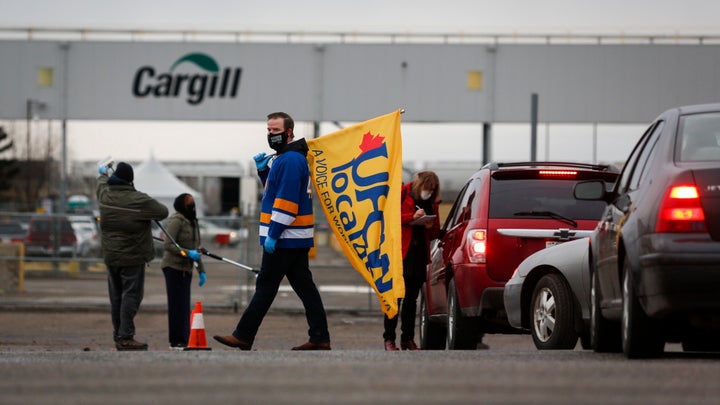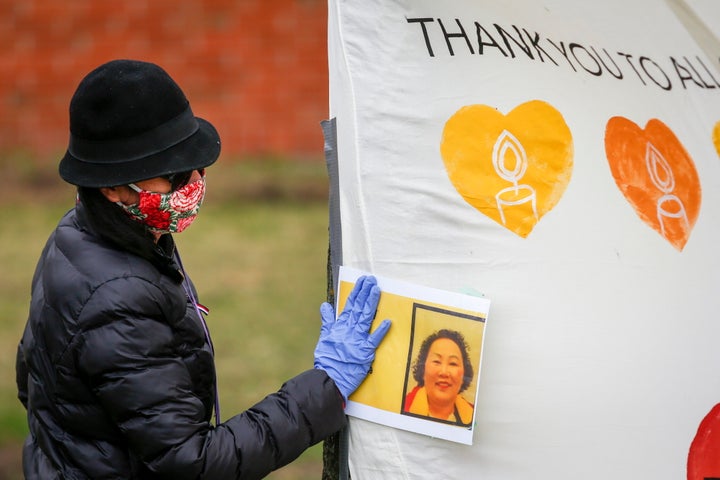
How do you maintain social distancing in the workplace?
It’s a question that is top of mind as businesses and services plan phased reopenings in the wake of the COVID-19 pandemic.
But not everyone’s been out of work.
Southern Alberta is now home to North America’s single largest COVID-19 outbreak, with more than 1,500 cases linked to the Cargill meat-packing plant near High River, according to provincial health officials. Nearly half of the plant’s 2,000 workers have tested positive for the novel coronavirus. One worker, Hiep Bui, a Vietnamese immigrant who’d worked for Cargill for 23 years, died in mid-April after contracting the virus.
But on Monday, the same day Bui’s memorial was held, the plant reopened following its closure due to the outbreak and workers returned to the facility that processes over a third of all of Canada’s beef.
WATCH: Alberta surpasses 3,000 COVID-19 cases. Story continues below.
According to a survey of more than 600 workers conducted by the union, 85 per cent reported that they were afraid to return to work and 80 per cent said they did not want the plant to reopen Monday.
But it did, with added temperature checks at the door and increased social distancing and protection measures inside, according to management.
As provinces start to “reopen” their economies, more and more workers will be returning to the physical workplace in the coming weeks and months.
But what workplace safeties are those workers entitled to? And what must businesses legally do to protect their workers and maintain social distancing?
When can a worker refuse unsafe work?
While exact wording of legislation varies from province to province, most provinces have some sort of Occupational Health and Safety Act (OHSA) in place to define a worker’s right to refuse unsafe work.
In Ontario, under the OHSA a worker can refuse to work if he or she has reason to believe that:
- any machine, equipment or tool that the worker is using or is told to use is likely to endanger himself or herself or another worker
- the physical condition of the workplace or workstation is likely to endanger himself or herself
- workplace violence is likely to endanger himself or herself
- any machine, equipment or tool that the worker is using, or the physical condition of the workplace, contravenes the Act or regulations and is likely to endanger himself or herself or another worker
So where does COVID-19 fit into that? It will be up to how employers, safety inspectors and the labour relations board interpret social distancing guidelines in relation to that second bullet point on whether the physical condition of the workplace will endanger a worker.
Previously that was usually in reference to something like a tripping hazard or danger of heavy objects falling. But in a world where COVID-19 can spread so easily through respiratory droplets, it could also apply to situations where workers cannot be six feet apart.
For example, if a worker feels like their workplace is not instituting proper social distancing guidelines and that makes them feel unsafe, they can refuse the work and communicate that to their supervisor, employer and/or workplace health and safety representative.
Those parties investigate and either resolve the situation, allowing the worker to return to work feeling safe, or it moves to the second stage. If the worker still feels unsafe, they or the employer can call the Ministry of Labour. Then an inspector will come assess the situation and make a ruling, potentially ordering changes.

In B.C. the parameters are similar, only provincial agency WorkSafe B.C. fulfils the role of the Ministry of Labour. In Alberta, assessments of unsafe working conditions are done through Occupational Health and Safety.
A grey area
But according to McMaster University labour studies professor Judy Fudge, it’s not always simple when it comes to COVID-19.
In Ontario, because social distancing and COVID-19 health advice is regulated under the provincial and municipal states of emergency, Fudge says many workers who go to the labour board with complaints related to social distancing in the workplace have been turned away and deferred to bylaw officers or public health officials.
“Some people who are working, want to follow those rules. So they talk to the health and safety rep, they talk to their employer, they call the Ministry of Labour, and they’re told that it’s not the Ministry of Labour’s job to enforce that rule by enforcement,” she said. “So people raise complaints in all of the appropriate forums. And no one responds to them.”
Fudge said that provinces, as they reopen, need to regulate social distancing and personal protective equipment standards in workplaces, and be clear about whose role it is to enforce those standards. Otherwise, each case will be up to the discretion of individual inspectors because exact regulations are fuzzy.
“Unless there’s a special order that came under [the] province’s emergency order — like what they did with respect to the long-term care facilities — or unless the workplace has the safety regulation that requires it, the only way personal protective devices or social distancing rules are enforceable is if the Ministry of Labour upholds the complaint,” she said.
The process to get COVID-19 workplace standards written into regulations, in Ontario at least, is an arduous one that involves changing the regulations through a provincial cabinet order, or directly changing the OHSA.
She says this should have been a conversation that happened after the 2003 SARS epidemic.
“Because we knew after SARS about vector transmission. We knew about it and we did nothing about it, nothing legislatively” she said. “Some hospitals changed their practices, but there was no legal requirement [for workplace safety standards].”
“The more dependent you are on your income from your employer, the less likely you are to make a fuss.”
- McMaster University labour studies professor Judy Fudge
And Fudge said that while workers can still argue their case and the Ministry of Labour or health and safety agency could still rule in their favour, many of the workers most vulnerable to unsafe workplaces in the pandemic are also already vulnerable or precarious.
Workplaces experiencing COVID-19 outbreaks and related social distancing issues now, like the meat-packing plants in Alberta, are primarily staffed by immigrant and low-income workers, many of whom may not feel comfortable bringing these issues up with management.
“The more dependent you are on your income from your employer, the less likely you are to make a fuss,” Fudge said. “Especially when you don’t have a union.”
Fudge said it’s still important that workers speak up if they feel unsafe.
“They should exercise their right to refuse unsafe work when they have reasonable grounds to do so,” she said. “But they’re going to have to start calling unions and calling reporters and making a fuss, because the province needs to address these complaints.”
Also on HuffPost: